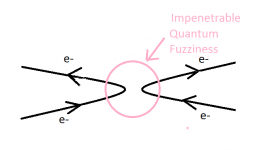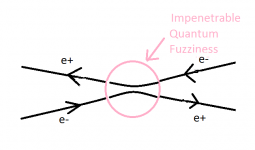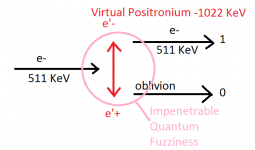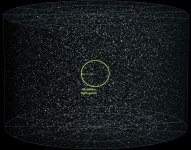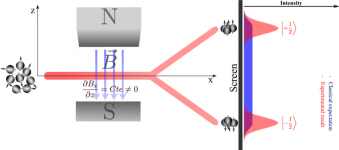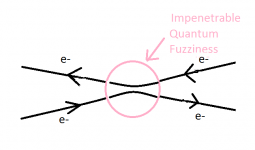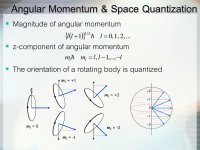No, I am alive and well. 😀
But have been getting back to basics, as John Major used to say... 😱
To get the noobs up to speed here, we have solved what the Universe is expanding into.
Does the universe have an edge? - BBC Science Focus Magazine
OK, so far? I am. 😎
I far prefer questions of mathematics, the Quantum and Geometry.
You are inside the Quantum horizon or Outside it. The Dark Universe versus the Light Universe. I make no judgements here.
Current research has involved the mysterious business of our Universes bias towards MATTER. No reason for it, but it's there, particularly with 2nd and 3rd generation particles.
Charm Meson Particle | What Is Antimatter?
I have been running various interactions up the flagpole.
Current theory indicates it's all about SPIN. Little understood IMO. 😎
Positronium - Wikipedia
More Geometry:
But have been getting back to basics, as John Major used to say... 😱
To get the noobs up to speed here, we have solved what the Universe is expanding into.
Does the universe have an edge? - BBC Science Focus Magazine
Of course, others will say the Universe does have an effective edge, because it was born 13.82 billion years ago in the Big Bang. We can therefore see only those galaxies whose light has taken less than 13.82 billion years to reach us (about two trillion).
Those galaxies exist in a sphere of space centred on the Earth that we call the ‘observable Universe’. It’s actually about 92 billion light-years across as the Universe ‘inflated’ far faster than the speed of light in its first split-second of existence.
The observable Universe is bounded by a ‘cosmic horizon’, much like the horizon at sea. Just as we know there’s more ocean over the horizon, we know there are more galaxies (possibly an infinite number) beyond the cosmic horizon. Their light simply hasn’t had time to reach us yet.
OK, so far? I am. 😎
I far prefer questions of mathematics, the Quantum and Geometry.
You are inside the Quantum horizon or Outside it. The Dark Universe versus the Light Universe. I make no judgements here.
Current research has involved the mysterious business of our Universes bias towards MATTER. No reason for it, but it's there, particularly with 2nd and 3rd generation particles.
Charm Meson Particle | What Is Antimatter?
I have been running various interactions up the flagpole.
Current theory indicates it's all about SPIN. Little understood IMO. 😎
Positronium - Wikipedia
More Geometry:
Attachments
I'm OK, as the observable Universe has been discussed on this thread.OK, so far? I am. 😎
The big question is, how large is the entire, unobservable Universe?
I'm sure I've posted this answer before: "The unobservable Universe, assuming there's no topological weirdness, must be at least 23 trillion light years in diameter, and contain a volume of space that's over 15 million times as large as the volume we can observe."
P.S. I asked Ethan: Ask Ethan: How Large Is The Entire, Unobservable Universe?
Attachments
And, we all know our oniums on this thread, or in proper speak, onia! 😀
Onium - Wikipedia
However, the charm meson's ability to toggle between its matter and antimatter states is new news!
Onium - Wikipedia
However, the charm meson's ability to toggle between its matter and antimatter states is new news!
Subatomic particle seen changing to antiparticle and back for the first time | University of Oxford"In the strange world of quantum physics, the charm meson can be itself and its antiparticle at once. This state, known as quantum superposition, results in two particles each with their own mass – a heavier and lighter version of the particle. This superposition allows the charm meson to oscillate into its antiparticle and back again.
Using data collected during the second run of the Large Hadron Collider, researchers from the University of Oxford measured a difference in mass between the two particles of 0.00000000000000000000000000000000000001 grams – or in scientific notation 1x10^-38g. A measurement of this precision and certainty is only possible when the phenomenon is observed many times, and this is only possible due so many charm mesons being produced in LHC collisions."
To understand SPIN, we have to go back to 1922 when Otto Stern and Walther Gerlach shot neutral silver atoms through a varying magnetic field.Current theory indicates it's all about SPIN. Little understood IMO. 😎
Instead of travelling through the field in a straight line, or spreading out evenly, the silver atoms separated themselves into two distinct groups, with one group heading up and the other going down.
Now, if those atoms behaved like little metal balls and could spin on their own axis, then their angular momentum would interact with the surrounding magnetic field, producing a torque which would result in a change in direction.
But, crucially, the experiment showed that there were only two directions of spin associated with the silver atoms.
As usual, physicists, were very unimaginative when naming the directions of this new property of 'spin'. For example, an electron can only have a spin +1/2 or -1/2, corresponding to the up and down deflections of the Stern-Gerlach experiment.
https://physicstoday.scitation.org/doi/10.1063/1.1650229
P.S. You could try this at home if you have strong magnetic fields and rapidly spinning metal balls! 😀
Attachments
Here’s a very nice presentation on space quantization, the SGE and electron spin
https://physics.unm.edu/Courses/Fields/Phys2310/Lectures/lecture41.pdf
(Ill be tapping into your brain to explain some of this stuff Galu 🙂 )
https://physics.unm.edu/Courses/Fields/Phys2310/Lectures/lecture41.pdf
(Ill be tapping into your brain to explain some of this stuff Galu 🙂 )
Amongst other "stuff", your 20 page pdf expands on the physics behind the Stern-Gerlach experiment, but far beyond my ability to explain the content in simple terms.
I definitely reached my limit of simplification in my previous post!
P.S. I remember doing an experiment on the Zeeman Effect (the splitting of spectral lines due to a magnetic field) in the lab at university - I should still have my handwritten report somewhere.
I definitely reached my limit of simplification in my previous post!

P.S. I remember doing an experiment on the Zeeman Effect (the splitting of spectral lines due to a magnetic field) in the lab at university - I should still have my handwritten report somewhere.
Bit of housekeeping before resuming Physics discussion...
I make it Comet! 🙂
Glaring mistake in my second particle collision:

This violates conservation of charge, so to be dismissed.
The next one is OK, IMO:
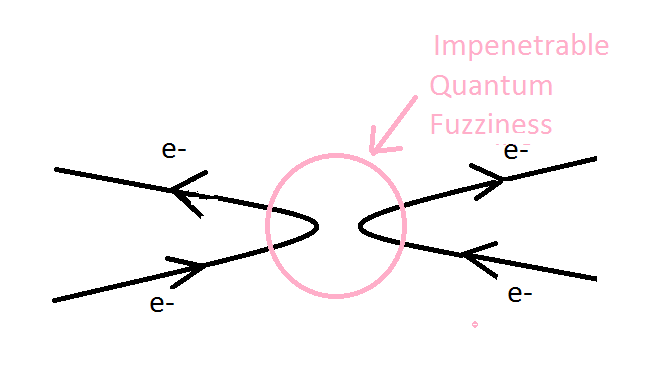
But we can't be sure exactly what has gone on, AFAIK. It could be like the attached collision! 😕
Lastly, what lies beyond the observable edge of our Universe? I have always known this. Beyond lies the Wub.
Beyond Lies the Wub - Wikipedia
OK?
Finally, the two-speed crossword. Caught my physics interest.
Cryptic Clue 10: "Body in space time to arrive first (5)"
Short Clue 10: "Tailed Orbiter (5)"
Fifth letter T, because 3 Down is "Midge (4)" which I made as GNAT.
I make it Comet! 🙂
Glaring mistake in my second particle collision:
This violates conservation of charge, so to be dismissed.
The next one is OK, IMO:
But we can't be sure exactly what has gone on, AFAIK. It could be like the attached collision! 😕
Lastly, what lies beyond the observable edge of our Universe? I have always known this. Beyond lies the Wub.
Beyond Lies the Wub - Wikipedia
OK?
Attachments
Back to this Charmed Meson business... apparently doing odd things between Matter and AntiMatter states. The D nought meson to be precise.
D meson - Wikipedia
Not to be confused with the Strange Meson, known as the Neutral Kaon which also does odd things in violating CP conservation:
Kaon - Wikipedia
Both being second generation Quarks. I didn't find the two previous physics links very useful, TBH. Stern-Gerlach is schoolboy stuff! 🙂
Unsurprisingly, the third generation Bottom Quarks exhibit the oddities of the Charmed D nought meson too, and this has been known for a while:
Er, that's where I have got to so far.
D meson - Wikipedia
Not to be confused with the Strange Meson, known as the Neutral Kaon which also does odd things in violating CP conservation:
Kaon - Wikipedia
Both being second generation Quarks. I didn't find the two previous physics links very useful, TBH. Stern-Gerlach is schoolboy stuff! 🙂
Unsurprisingly, the third generation Bottom Quarks exhibit the oddities of the Charmed D nought meson too, and this has been known for a while:
In 2021, and with a significance of more than seven standard deviations, it was confirmed that the neutral D0 meson spontaneously transforms into its own antiparticle and back. This phenomenon is called flavor oscillation and was prior known to exist in the neutral B mesons.
Er, that's where I have got to so far.
I assume that by ‘space quantization’ they are talking about in the SGE they are referring to the electron energy bands?
By "quantized in space", the lecture simply refers to the fact that the angular momentum vector of a silver atom can't just point in any old direction in space, but only in one of two possible directions.
Current theory indicates it's all about SPIN. Little understood IMO. 😎
To my mind, your two statements are contradictory.Stern-Gerlach is schoolboy stuff! 🙂
To understand something, you have to start at the beginning!
I had a look into "space quantization" to find that it refers to an atom in a magnetic field "whose quantum states correspond to a limited number of possible angles between the directions of the angular momentum and the magnetic intensity".I assume that by ‘space quantization’ they are talking about in the SGE they are referring to the electron energy bands?
In your lecture pdf, the quantum states of an atom are referred to on page 2 and are, indeed, linked to spectral analysis.
I'm now re-aquainting myself with quantum states and their relation to Bonsai's "electron energy bands". 😎
According to Bonsai's pdf - https://physics.unm.edu/Courses/Fields/Phys2310/Lectures/lecture41.pdf - each quantum state of an electron is determined by the quantum numbers n, l and ml.
These are, in order, the principal quantum number, the orbital quantum number and the magnetic quantum number.
A fourth quantum number, the spin quantum number ms, arises from electron spin.
Quantum numbers for hydrogen atom
The orbital quantum number l is used as a part of the designation of atomic electron states in the spectroscopic notation i.e. it's related to the atomic orbitals s, p, d and f.
The orbital quantum number l determines the magnitude of the orbital angular momentum L.
Hydrogen Schrodinger Equation
(The hyperphysics site is great for clicking on explanatory links, by the way!)
The attached slide shows how the orientation of a rotating body is quantized in relation to the magnetic quantum number ml.
According to Bonsai's pdf - https://physics.unm.edu/Courses/Fields/Phys2310/Lectures/lecture41.pdf - each quantum state of an electron is determined by the quantum numbers n, l and ml.
These are, in order, the principal quantum number, the orbital quantum number and the magnetic quantum number.
A fourth quantum number, the spin quantum number ms, arises from electron spin.
Quantum numbers for hydrogen atom
The orbital quantum number l is used as a part of the designation of atomic electron states in the spectroscopic notation i.e. it's related to the atomic orbitals s, p, d and f.
The orbital quantum number l determines the magnitude of the orbital angular momentum L.
Hydrogen Schrodinger Equation
(The hyperphysics site is great for clicking on explanatory links, by the way!)
The attached slide shows how the orientation of a rotating body is quantized in relation to the magnetic quantum number ml.
Attachments
Last edited:
I had a look into "space quantization" to find that it refers to an atom in a magnetic field "whose quantum states correspond to a limited number of possible angles between the directions of the angular momentum and the magnetic intensity".
In your lecture pdf, the quantum states of an atom are referred to on page 2 and are, indeed, linked to spectral analysis.
Ok - got it. This is what the Zeeman effect, right?
Apparently, in the Zeeman effect, the spectral lines are split due to the distortion of electron orbitals due to the magnetic field.
Had to stop there to take what proved to be a long phone call!
The splitting of the spectral lines is all to do with angular momentum again.
In the Normal Zeeman effect, an orbital has more than one possible angular momentum quantum states.
The effect of the magnetic field is to separate the three states into three different energy levels. One is the original level and the other two are higher and lower levels.
Hence the original spectral line is split into three lines corresponding to the three different energy levels.
The splitting of the spectral lines is all to do with angular momentum again.
In the Normal Zeeman effect, an orbital has more than one possible angular momentum quantum states.
The effect of the magnetic field is to separate the three states into three different energy levels. One is the original level and the other two are higher and lower levels.
Hence the original spectral line is split into three lines corresponding to the three different energy levels.
Attachments
However, as your pdf points out, the number of spectral lines can be even and not odd.
This is called the Anomalous Zeeman effect and is explained by the inclusion of electron spin in the total angular momentum.
This is called the Anomalous Zeeman effect and is explained by the inclusion of electron spin in the total angular momentum.
Attachments
Last edited:
- Status
- Not open for further replies.
- Home
- Member Areas
- The Lounge
- What is the Universe expanding into..
